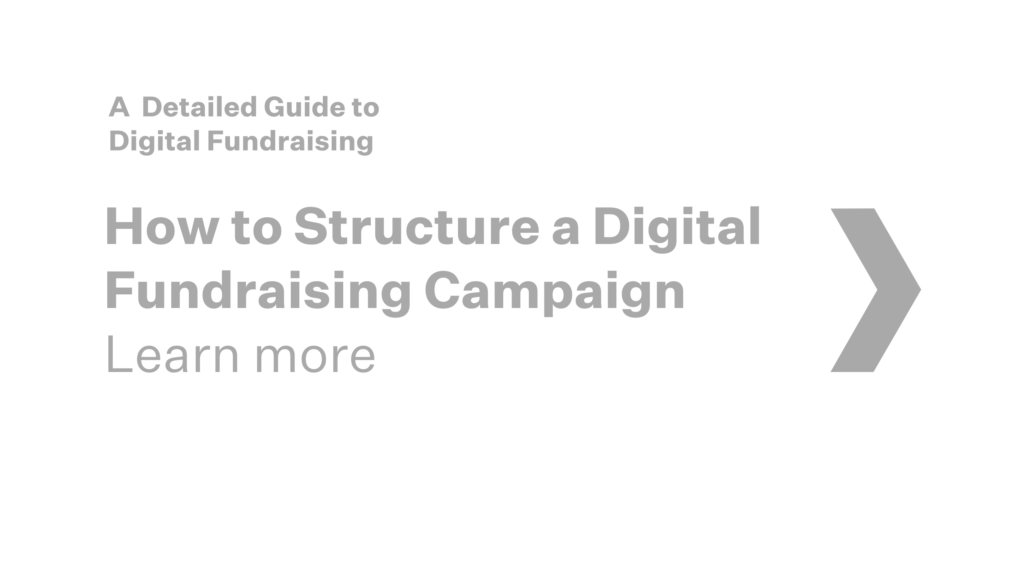
This article is part of the series, “A detailed Guide to Digital Fundraising”. Read the Table of Contents for a full list of articles.
When you create your first digital fundraising campaign, the systems you implement – although they might require tweaking or updating – should remain in place for all future campaigns. To implement a plan effectively you will need to think about how people will interact with your content, a tone that will resonate with your target audience, identify where you position your content, what data you would like to capture and how. Here are a few things that should sit at the heart of your digital fundraising campaign:
3.1 PERSONAS
The process of creating personas is essentially stereotyping the types of individual investors, donors or people that are important to you. These individuals might be members of the public or employees with a certain role in an organisation. You must breakdown your audience into separate groups so that you can then customise content and campaigns for them. When creating content with your identified personas in mind, you will increase the relevance and performance of a campaign. Here are a selection that could be chosen. Please note: each example could also have a range of different personas within it.- 3.1.1 Investment Management – advisers, investors, intermediaries, management teams of addressable market.
- 3.1.2 Charities – activists, trusts, target demographics, HNWs, doctors, teachers, ESG influencers.
- 3.1.3 Listed Businesses – existing investors, potential institutional, intermediary and retail investors
3.2 COMMUNICATIONS + MESSAGING
Once you have completed the groundwork of your personas you will need to start creating content that speaks directly to them in the correct tone of voice. Most branding guidelines have some rules on tone of voice. Here are some examples to help you think about what you might be looking to communicate within any given year of creating campaigns.3.2.1 CAMPAIGN TYPES:
There are many expressions that people use to describe different types of content. These include, “Evergreen” and” topical” content or “Hero hub and hygiene”. They are all similar and cover the same principles. We describe them as:- Flagship content – centrepieces to hang your brand and identity on
- Educational – guides and overviews to ways of working
- Search related – creating content based on what your customers are looking for
- Reactive – responding to changes and events within your sector or market
- Thought leadership – sector insights and views on future trends and innovations that can establish people or companies as an authority on relevant topics and discussions
3.3 CONVERSIONS
Conversions are a critical part to any digital ecosystem and campaign. Enabling people to connect with your business and convert as a new contact is a crucial part of this exercise. Careful consideration is needed when determining and structuring your conversions, they will also require constant monitoring. You must focus your conversions around what is important to your organisation, your business goals and KPIs. Although your end goal might be for a user to purchase a product or invest from your website, it must be noted that not all users will want to be directed to a donate/buy/invest now landing page and can often be put off by this. This is where customer nurturing is important and other softer conversion opportunities should be considered. Here are a few examples of other conversions:- Follow on LinkedIn (or other social channel)
- Subscribe to a newsletter or alert
- Request a meeting/call or demonstration
- Download key information or a report
3.4 DIGITAL FRAMEWORK
Your digital framework covers what technologies you use as part of your online presence. This can start with how you publish your content, third party measurement and analytics tools, tracking codes, landing pages, automation tools, CMS and CRMs. It is vital that you map out your digital framework and tools in order to decide what you use and how you can monitor and improve campaigns. This exercise also helps you determine where you gather your data and what types of data you collect. As things evolve at speed, often it is easy to replace or upgrade any of these by simply plugging in a new tool (for less money or more functionality) even if just for a trial alongside your existing set up.3.5 CONTENT FRAMEWORK
Similar to your digital framework, your content framework maps out where your content sits within your digital channels. If you have established your personas and conversions you will realise that people can have varying levels of understanding and sophistication in terms of knowledge of your services or market and they will also be signing up or converting for a variety of different reasons. This means you need to structure your content appropriately. You will need to make sure that you support the decision making process of your target audience in a variety of ways. In some cases this may be generic content that introduces people to who you are and what you do. In other cases it may be covering fairly complex insights and explanations with more technical information. The basic cycle can usually explained like this:- 3.5.1 Attract – capture people’s attention and bring them closer to your company
- 3.5.2 Interest – support their attention with content that builds a connection with your business
- 3.5.3 Assess – content to support the decision making process and generate top tier conversions
- 3.5.4 Manage – maintaining contact with your existing network, ambassadors and customers
3.6 USER EXPERIENCE + USER JOURNEYS
The terms ‘user experience’ and user journeys’ are often mixed up or interchanged. User experience is often referred to how people experience a specific product, website or app while they are using it. Our focus is on the user journey, this is a person’s experience, consisting of a series of actions performed to achieve a particular goal. This starts from an initial touch point, perhaps on social media, through to visiting a website, exploring several articles, pages and then converting. As you will have multiple personas you can expect that people will be attracted to different things and you will need to map out the desired and potential user journeys for each one.3.7 WORKFLOWS + AUTOMATION
Workflows and automation are the actions that are triggered when an event takes place. For instance, when a conversion happens – what happens next. Is the person sent an email to support the action they just completed? Is there a series of email triggers that reminds them to complete a task until it is done? Does anyone internally get sent an email to alert them of this event? If you set up reverse IP correctly and there is a visit from an active prospect, does the person responsible get notified? There are a number of rules and recipes you should put in place to ensure that manual tasks are reduced when key events happen and everyone gets the right information promptly. This is also helps measure the impact of campaigns and get buy-in across the organisation.3.8 PEER ANALYSIS + COMPETITOR REVIEWS
It is always a helpful exercise to review what your competitors are doing. Covering the content and campaigns they are creating as well as investigating how they are evolving digitally. Reviewing peers and also companies that you aspire to be like (even if they are in a different sector) is also useful. Create a list of at least three of the following:- Competitors – organisations you go head to head with
- Peers – companies in your sector your admire and respect
- Aspirations – world leading brands you would like to emulate
- General comments on the website
- Brand and Content
- Messaging
- Campaigns
- Digital planning and approach
- Social network activity
- General likes and dislikes
- Improvements you would recommend
